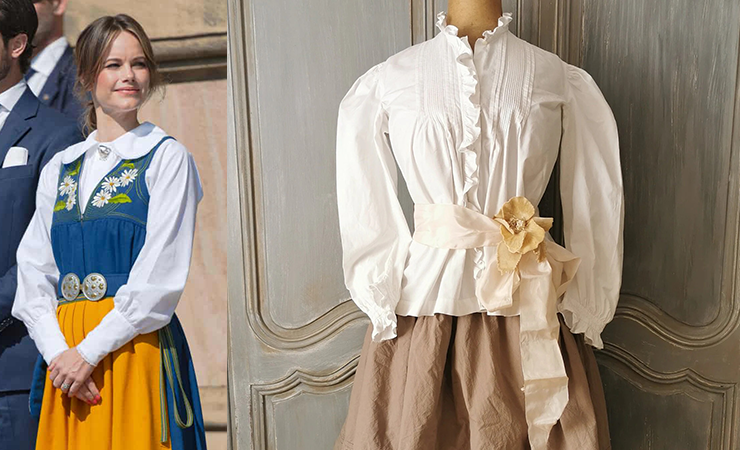
Swedish clothing is deeply rooted in tradition, offering a distinct style that reflects the country’s history, culture, and love for practicality. While modern Swedish fashion is often associated with minimalism, traditional Swedish clothing stands out for its vibrant colors, intricate patterns, and craftsmanship.
Traditional Swedish Women’s Clothing
The traditional attire for Swedish women, often worn during cultural festivals like Midsummer and other national events, is colorful and detailed. Here are five essential pieces that make up this traditional look:
Linnetröja (Linen Blouse)
The linnetröja is a fundamental part of Swedish women’s traditional clothing. This blouse, typically worn under a bodice, features puffed sleeves and is often decorated with embroidery around the collar and cuffs. Made from natural linen, it is both comfortable and breathable, reflecting Sweden’s preference for practical yet elegant garments.
Livstycke (Bodice)
The livstycke, or bodice, is a fitted, sleeveless garment worn over the blouse. It is commonly made from wool or velvet in vibrant colors like red, blue, or green and features detailed embroidery. This bodice is designed to accentuate the waist, creating a structured and flattering silhouette.
Kjol (Striped Skirt)
The traditional skirt, or kjol, is a key component of Swedish women’s attire. These skirts are often striped or plaid, featuring bold colors such as red, yellow, blue, and green. The ankle-length skirt is typically paired with an apron, creating a layered effect that adds volume and regional distinction to the outfit.
Förkläde (Apron)
Förkläde is an essential part of Swedish women’s traditional dress. Worn over the skirt, this apron is usually white or decorated with floral embroidery. It serves both a functional and decorative purpose, adding elegance while showcasing traditional Swedish craftsmanship.
Huva (Kerchief or Bonnet)
Head coverings like the huva are commonly worn by Swedish women as part of their traditional attire. These headpieces, often made of linen or wool, are adorned with lace or embroidery and symbolize modesty. They vary in design, with more elaborate versions reserved for festive occasions.
Traditional Swedish Men’s Clothing
Swedish men’s traditional attire is characterized by its practicality and craftsmanship, suitable for Sweden’s outdoor lifestyle and climate. Here are five essential elements of this traditional look:
Linneskjorta (Linen Shirt)
The linneskjorta is a long-sleeved linen shirt and the foundation of traditional Swedish men’s attire. It features simple embroidery on the cuffs and collar and is typically worn tucked into trousers or underneath a vest. The loose fit allows for ease of movement and comfort.
Väst (Wool Vest)
Worn over the linen shirt, the väst is a tailored wool vest, often featuring buttons and minimal embroidery. This vest adds warmth while giving the outfit a structured and polished appearance. Common colors include deep blue, red, or black, highlighting a balance between practicality and style.
Knäbyxor (Knee-Breeches)
The knäbyxor are knee-breeches that end just below the knee. Made from wool or linen, these trousers are designed for flexibility and are secured with buttons or ties. This style allows for easy movement, especially during physical work or traditional dances.
Strumpor (Stockings)
Knee-breeches are paired with long woolen stockings, known as strumpor, to provide warmth and comfort. Typically white or gray, these stockings are often hand-knitted and held up by garters, which add another layer of tradition to the outfit.
Mössa (Woolen Cap)
Mössa is a woolen cap, an essential accessory in Swedish men’s traditional clothing. Simple in design and neutral in color, the cap serves to keep the head warm during colder months. In certain regions, men wear more elaborate versions of this cap during special events, reflecting regional craftsmanship.
Modern Swedish Clothing
Contemporary Swedish fashion has embraced a minimalist aesthetic, focusing on clean lines, neutral tones, and sustainable materials. Brands like “Acne Studios” and “Filippa K” are known for producing modern, timeless pieces that align with Sweden’s appreciation for functionality and simplicity. However, the influence of traditional clothing is still visible, with designers occasionally incorporating natural fabrics and folk-inspired embroidery into their collections, blending Sweden’s rich history with modern sensibilities.
The post Complete Guide to Swedish Clothing appeared first on The Fashiongton Post.
